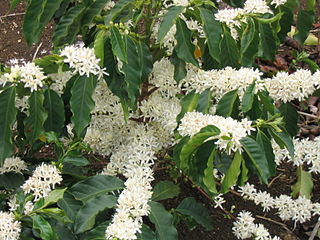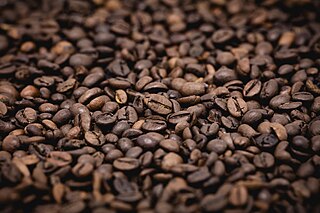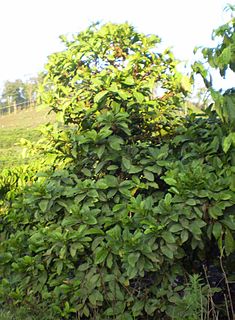Related Research Articles

Coffea is a genus of flowering plants in the family Rubiaceae. Coffea species are shrubs or small trees native to tropical and southern Africa and tropical Asia. The seeds of some species, called coffee beans, are used to flavor various beverages and products. The fruits, like the seeds, contain a large amount of caffeine, and have a distinct sweet taste and are often juiced. The plant ranks as one of the world's most valuable and widely traded commodity crops and is an important export product of several countries, including those in Central and South America, the Caribbean and Africa.

Coffee is a brewed drink prepared from roasted coffee beans, the seeds of berries from certain Coffea species. From the coffee fruit, the seeds are separated to produce a stable, raw product: unroasted green coffee. The seeds are then roasted, a process which transforms them into a consumable product: roasted coffee, which is ground into fine particles that are typically steeped in hot water before being filtered out, producing a cup of coffee.

Kopi luwak is a coffee that consists of partially digested coffee cherries, which have been eaten and defecated by the Asian palm civet. It is also called civet coffee. The cherries are fermented as they pass through a civet's intestines, and after being defecated with other fecal matter, they are collected. Asian palm civets are increasingly caught in the wild and traded for this purpose.

Coffea arabica, also known as the Arabian coffee, is a species of flowering plant in the coffee and madder family Rubiaceae. It is believed to be the first species of coffee to have been cultivated, and is currently the dominant cultivar, representing about 60% of global production. Coffee produced from the robusta bean makes up most of the remaining coffee production. Arabica coffee originates from Ethiopia and was first cultivated in Yemen, and documented by the 12th century. Coffea arabica is called بُنّ in Arabic, borrowed from the Oromo "Buna".

The National Federation of Coffee Growers of Colombia,, abbreviated as Colombian Coffee Growers Federation or Fedecafé, is a non-profit business organization, popularly known for its "Juan Valdez" marketing campaign. The Federation was founded in 1927 as a business association that promotes production and exportation of Colombian coffee. It currently represents over 540,000 producers, most of whom are small family owned farms.

Coffea canephora is a species of coffee that has its origins in central and western sub-Saharan Africa. It is a species of flowering plant in the family Rubiaceae. Though widely known as Coffea robusta, the plant is scientifically identified as Coffea canephora, which has two main varieties, robusta and nganda.

The history of coffee begins in legend. According to one legend, ancestors of today's Oromo people in a region of Jimma in Ethiopia were the first to recognize the energizing effect of the coffee plant. However, no direct evidence that has been found earlier than the 15th century, or even where coffee was first cultivated. The story of Kaldi, the 9th-century Ethiopian goatherd who discovered the stimulating effect of coffee when he noticed how excited his goats became after eating the beans from a coffee plant, did not appear in writing until 1671 and is probably apocryphal.

Coffee is a popular beverage and an important commodity. Tens of millions of small producers in developing countries make their living growing coffee. Over 2.25 billion cups of coffee are consumed in the world daily. Over 90 percent of coffee production takes place in developing countries—mainly South America—while consumption happens primarily in industrialized economies. There are 25 million small producers who rely on coffee for a living worldwide. In Brazil, where almost a third of the world's coffee is produced, over five million people are employed in the cultivation and harvesting of over three billion coffee plants; it is a more labour-intensive culture than alternative cultures of the same regions, such as sugar cane or cattle, as its cultivation is not automated, requiring frequent human attention.

Kapeng barako, also known as Barako coffee or Batangas coffee, is a coffee varietal grown in the Philippines, particularly in the provinces of Batangas and Cavite. It belongs to the species Coffea liberica. The term is also used to refer to all coffee coming from those provinces. Barako in the languages of the Philippines means "stud", and is associated with the image of masculinity. Barako has a strong flavor and fragrance reminiscent of aniseed.

Coffea liberica, commonly known as the Liberian coffee, is a species of flowering plant in the family Rubiaceae from which coffee is produced. It is native to western and central Africa from Liberia to Uganda and Angola, and has become naturalised in the Philippines, Indonesia, Seychelles, the Andaman & Nicobar Islands, and Malaysia.

Indonesia was the fourth-largest producer of coffee in the world in 2014. Coffee cultivation in Indonesia began in the late 1600s and early 1700s, in the early Dutch colonial period, and has played an important part in the growth of the country. Indonesia is geographically and climatologically well-suited for coffee plantations, near the equator and with numerous interior mountainous regions on its main islands, creating well-suited microclimates for the growth and production of coffee.
Giling Basah is a term used by Indonesian coffee processors to describe the method they use to remove the hulls of Coffea arabica. Literally translated from Indonesian, the term means "wet grinding".

Coffee production in India is dominated in the hill tracts of South Indian states, with Karnataka accounting for 71%, followed by Kerala with 21% and Tamil Nadu. Indian coffee is said to be the finest coffee grown in the shade rather than direct sunlight anywhere in the world. There are about 250,000 coffee growers in the country; 98% of them are small growers. As of 2009, Indian coffee made up just 4.5% of the global production. Almost 80% of Indian coffee is exported; 70% is bound for Germany, Russia, Spain, Belgium, Slovenia, United States, United Kingdom, Japan, Greece, Netherlands and France. Italy accounts for 29% of the exports. Most of the export is shipped through the Suez Canal.

Coffee production in the Philippines began as early as 1740 when the Spanish introduced coffee in the islands. It was once a major industry in the Philippines, which 200 years ago was the fourth largest coffee producing nation.

Coffee production in Tanzania is a significant aspect of its economy as it is Tanzania's largest export crop. Tanzanian coffee production averages between 30-40,000 metric tons annually of which approximately 70% is Arabica and 30% is Robusta.

Coffee is Uganda's top-earning export crop. In 1989 Uganda's coffee production capacity exceeded its quota of 2.3 million bags, but export volumes were still diminished by economic and security problems, and large amounts of coffee beans were still being smuggled out of Uganda for sale in neighbouring countries.

Thailand is one of the top 25 coffee producers in the world as of 2014, but its status as a coffee origin has not been widely known. Thailand traditionally produced mainly Robusta for industrial use, but the country has quickly become an exciting emerging origin for specialty Arabica and fine Robusta coffees. The origin is unique in that it exports very little coffee and most of the consumption remains in the country. There is a booming specialty coffee ecosystem where farmers, roasters, cafes and consumers symbiotically co-exist. Despite, rooms for improvement, it is often seen as an example of a working coffee ecosystem for an origin where coffee produced is sustainable from both economic and environmental perspectives. This is a rare phenomenal in the coffee world.
Modern cultivation of coffee in China began in 1988. In 2016 and 2017, China was among the top 20 worldwide producers of coffee. Ninety-eight per cent of the coffee grown in China comes from Yunnan province.
The coffee industry of Timor Leste is an industry which remains the national economy's largest non-oil export. Since the introduction of coffee by the Portuguese in the 1800s, the industry contributes a sizeable portion of the country's employment and investment, and is a key income for rural communities. The industry is vulnerable to global coffee price fluctuation, deficient infrastructure, and lack of capital.
References
- ↑ "The Diverse Coffees of Indonesia". Specialty Coffee Association of Indonesia. Archived from the original on August 1, 2008. Retrieved 2008-08-08.
- ↑ "Trade statistics". International Coffee Organization. Retrieved 2008-08-08.
- ↑ Lingle, T: The State of the Specialty Coffee Industry, Tea and Coffee Trade Journal, July, 2007 Retrieved 2008-08-08
- ↑ "Supporting organizations". Asia Barista Championship. Retrieved 2008-08-08.
- ↑ "Cupping with Mr. Ted Lingle". Brother Baba Budan. Retrieved 2008-08-08.
- ↑ AMARTA Newsletter, A New Trade Association Promotes Indonesia’s Specialty Coffee in the United States, May 2008: Retrieved on 2008-08-08
